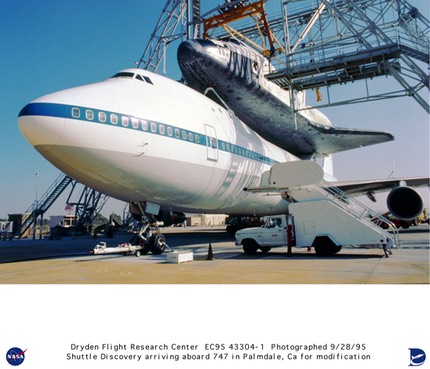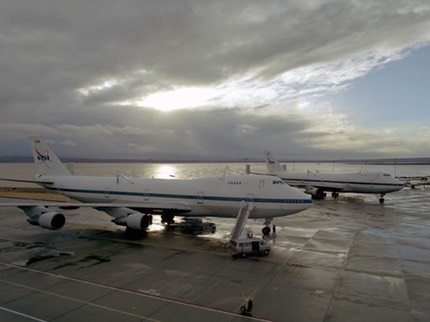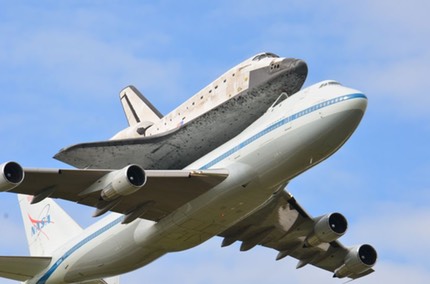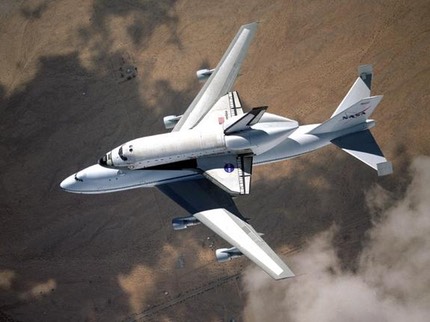NASA uses two modified Boeing 747 jetliners, originally manufactured for commercial use, as Shuttle Carrier Aircraft (SCA). One is a 747-100 model (NASA 905), while the other is a short range 747-100SR (NASA 911). The two aircraft are identical in appearance and performance.
The 747 series of aircraft are four-engine intercontinental-range, swept-wing "jumbo jets" that entered commercial service in 1969. The two SCAs are under the operational control of NASA's Johnson Space Center, Houston, TX.
The SCAs are used to ferry Space Shuttle orbiters from landing sites back to the Kennedy Space Center launch complex in Florida and also to and from other locations too distant for the orbiters to be delivered by ground transportation.
An orbiter is placed atop the SCA by a Mate-Demate Device (MDD), a large gantry-like structure that hoists the orbiter off the ground for post-flight servicing, and then mates it with the SCA for ferry flights.
Features which distinguish the two SCAs from standard 747 jetliners are:
- Three struts, with associated interior structural strengthening, protrude from the top of
the fuselage (one forward, two aft) on which the orbiter is attached
- Two additional vertical stabilizers, one on each end of the standard horizontal stabilizer,
to enhance directional stability
- Removal of all interior furnishings and equipment aft of the forward cabin doors
- Instrumentation used by SCA flight crews and engineers to monitor orbiter electrical loads during the ferry flights and also during pre- and post-ferry flight operations
NASA 905
NASA 905 was obtained from American Airlines in 1974 and became the first SCA. Shortly after it was accepted by NASA it was flown in a series of wake vortex research flights at the Dryden Flight Research Center in a study to seek ways of reducing turbulence produced by large aircraft. Pilots flying as much as several miles behind large aircraft have encountered wake turbulence that have caused control problems. The NASA study helped the Federal Aviation Administration (FAA) modify flight procedures for commercial aircraft during airport approaches and departures.
Following the wake vortex studies, NASA 905 was modified by Boeing to its present SCA configuration and the aircraft was returned to Dryden for its role in the 1977 Space Shuttle Approach and Landing Tests (ALT). This series of eight captive and five free flights with the orbiter prototype Enterprise, in addition to ground taxi tests, validated the aircraft's performance as an SCA, in addition to verifying the glide and landing characteristics of the orbiter configuration paving the way for orbital flights.
NASA 911
NASA 911 entered service with as an SCA in November 1990. It was obtained from Japan Airlines (JAL) in 1989 and modified by Boeing.




Images courtesy of NASA
